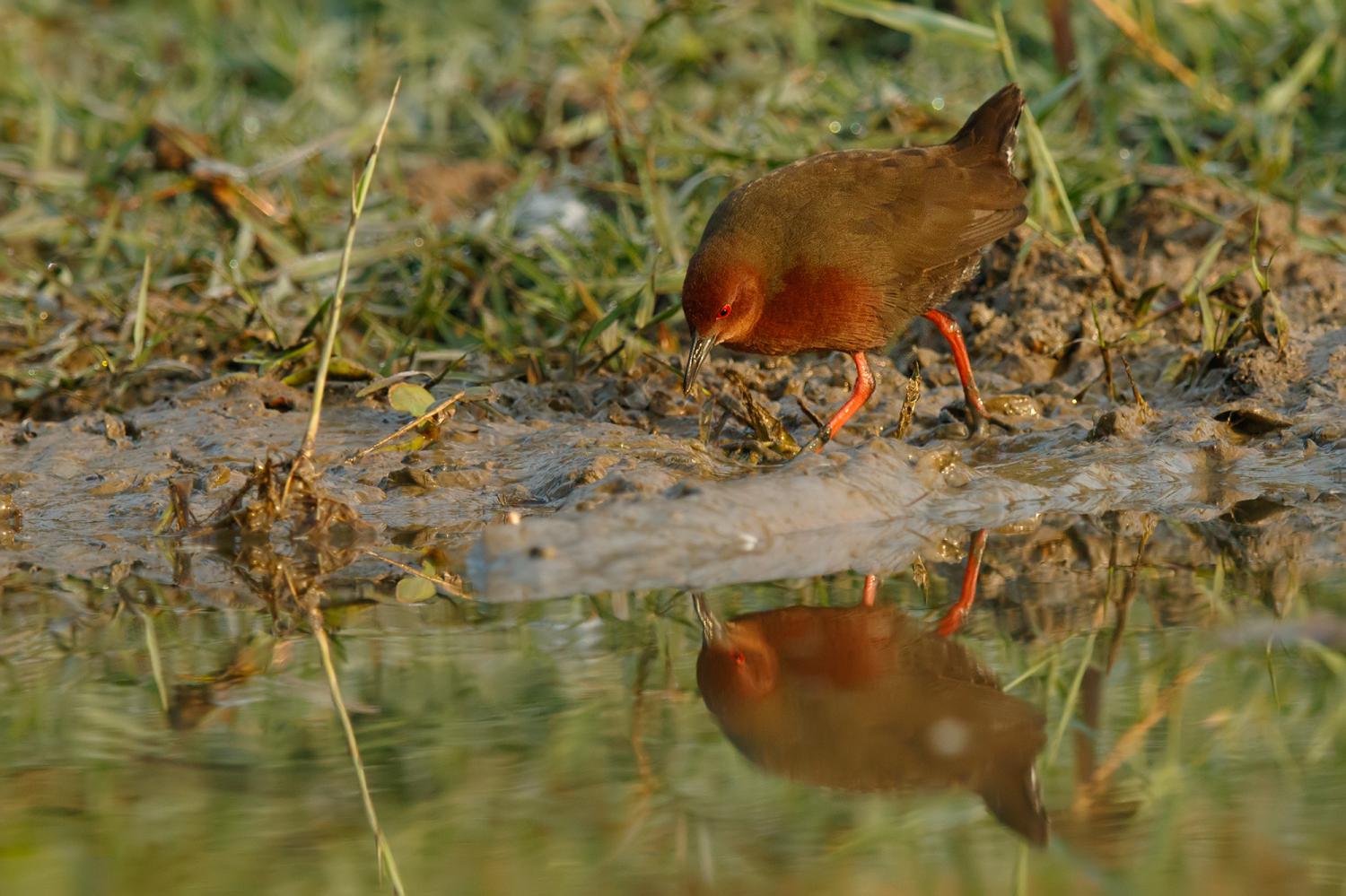Species of Thailand
Ruddy-breasted crake
Zapornia fusca
Carolus Linnaeus, 1766
In Thai: นกหนูแดง
The ruddy-breasted crake (Zapornia fusca), or ruddy crake, is a waterbird in the rail and crake family Rallidae.
Its breeding habitat is swamps and similar wet areas across South Asia from the Indian subcontinent east to south China, Japan and Indonesia. It has been recorded as a vagrant from the Australian territory of Christmas Island. It is mainly a permanent resident throughout its range, but some northern populations migrate further south in winter.
This crake nests in a dry location on the ground in marsh vegetation, laying 6-9 eggs.
The ruddy-breasted crake is about 22–23 cm long. The body is flattened laterally to allow easier passage through the reeds or undergrowth. It has long toes and a short tail. Coloring includes a pale brown back and chestnut head and underparts, with white barring on the flanks and undertail. The bill is yellowish, and the eyes, legs, and feet are red.
The sexes are similar, but juveniles are dark brown with some white spotting.
These birds probe in mud or shallow water and also pick up food by sight. They forage for shoots, berries and insects, as well as large snails, which they eat by using their bills to peck through the hard shell.
Ruddy-breasted crakes are territorial, but are quite secretive, hiding amongst grassy shrubs and bushes when disturbed.
This article uses material from Wikipedia released under the Creative Commons Attribution-Share-Alike Licence 3.0. Eventual photos shown in this page may or may not be from Wikipedia, please see the license details for photos in photo by-lines.
Category / Seasonal Status
BCST Category: Recorded in an apparently wild state within the last 50 years
BCST Seasonal statuses:
- Resident or presumed resident
- Non-breeding visitor
Scientific classification
- Kingdom
- Animalia
- Phylum
- Chordata
- Class
- Aves
- Order
- Gruiformes
- Family
- Rallidae
- Genus
- Zapornia
- Species
- Zapornia fusca
Common names
- Thai: นกหนูแดง
Conservation status

Least Concern (IUCN3.1)
Photos
Please help us review the bird photos if wrong ones are used. We can be reached via our contact us page.
Range Map

- Amphawa District, Samut Songkhram
- Ban Laem District, Phetchaburi
- Ban Phai District, Khon Kaen
- Bang Phra Non-Hunting Area
- Bang Pu Recreation Centre
- Bangkok Province
- Borabue District, Maha Sarakham
- Chiang Dao District, Chiang Mai
- Chiang Dao Wildlife Sanctuary
- Chiang Saen District, Chiang Rai
- Doi Inthanon National Park
- Doi Lo District, Chiang Mai
- Fang District, Chiang Mai
- Hat Yai District, Songkhla
- Kaeng Krachan National Park
- Kamphaeng Saen District, Nakhon Pathom
- Khao Sam Roi Yot National Park
- Khao Sok National Park
- Khao Yai National Park
- Khao Yoi District, Phetchaburi
- Khlong Luang District, Pathum Thani
- Khura Buri District, Phang Nga
- Klaeng District, Rayong
- Ko Phra Thong
- Laem Pak Bia
- Mae Ai District, Chiang Mai
- Mae Taeng District, Chiang Mai
- Mueang Chiang Mai District, Chiang Mai
- Mueang Chonburi District, Chonburi
- Mueang Kanchanaburi District, Kanchanaburi
- Mueang Khon Kaen District, Khon Kaen
- Mueang Krabi District, Krabi
- Mueang Nakhon Nayok District, Nakhon Nayok
- Mueang Nonthaburi District, Nonthaburi
- Mueang Pattani District, Pattani
- Mueang Phetchaburi District, Phetchaburi
- Mueang Samut Sakhon District, Samut Sakhon
- Mueang Samut Songkhram District, Samut Songkhram
- Mueang Suphanburi District, Suphan Buri
- Mueang Tak District, Tak
- Mueang Udon Thani District, Udon Thani
- Nong Bong Khai Non-Hunting Area
- Nong Song Hong District, Khon Kaen
- Pak Thale
- Pha Daeng National Park
- Phi Phi Islands
- Phra Nakhon Si Ayutthaya District, Phra Nakhon Si Ayutthaya
- Sai Noi District, Nonthaburi
- Samut Prakan Province
- Sanam Bin Reservoir Non-Hunting Area
- Takua Pa District, Phang Nga
- Tha Sala District, Nakhon Si Thammarat
- Thalang District, Phuket
- Than Sadet - Koh Pha-Ngan National Park
- Thanyaburi District, Pathum Thani
- Wat Phai Lom & Wat Ampu Wararam Non-Hunting Area
